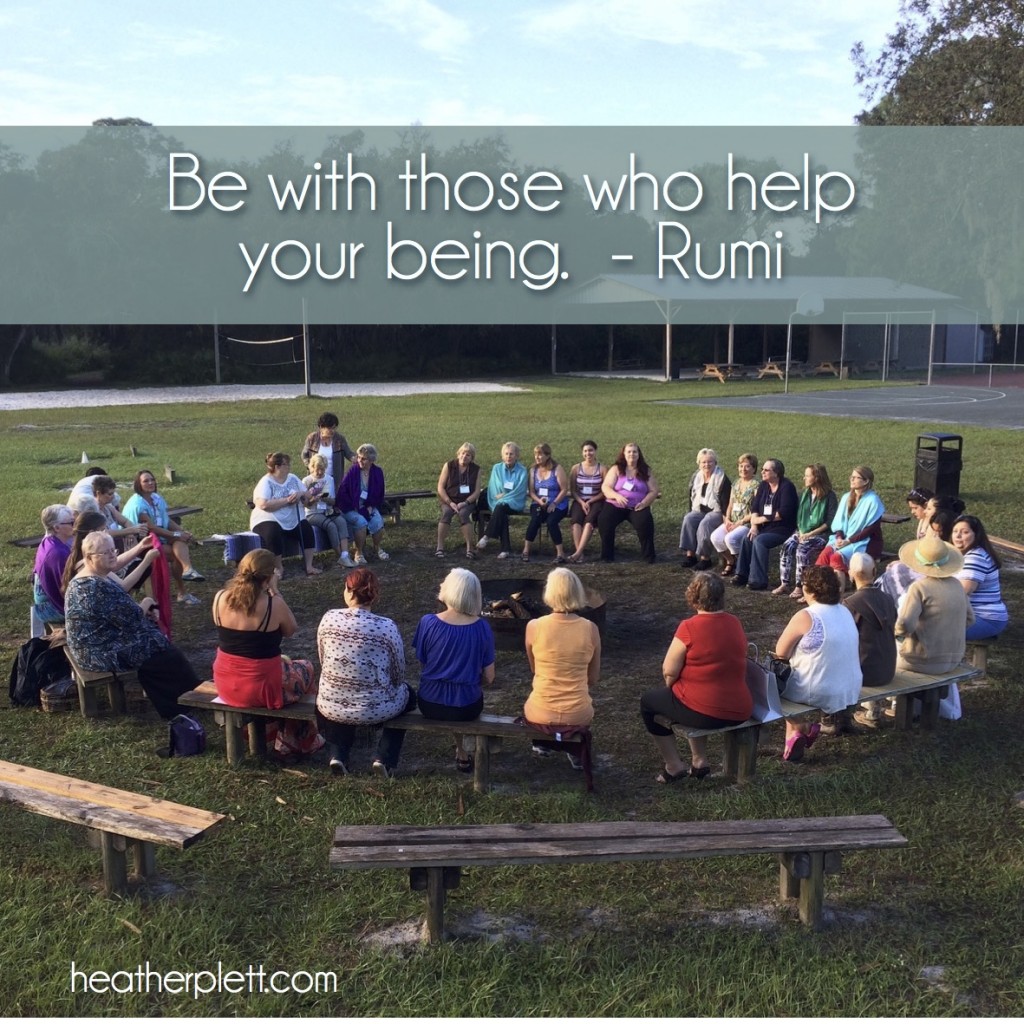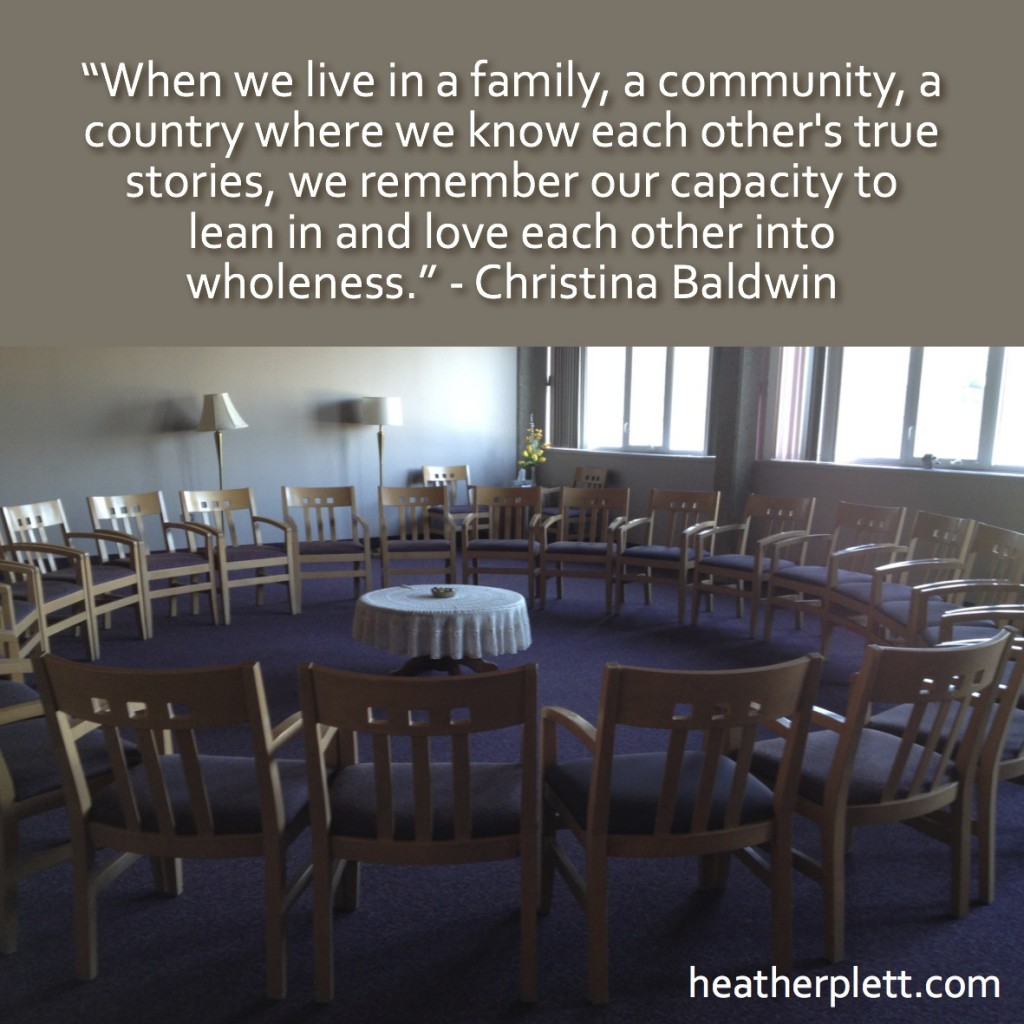What happens when you find your tribe?
There was a time in my life when I was really lonely. If you had been an observer watching my life, you probably wouldn’t have seen much evidence of the loneliness. I was a busy mom with great kids, I had a good job with co-workers who were easy to work with, and I had a few friends and family members around to socialize with, so it didn’t look like a lonely life. But I was lonely nonetheless. (Which leads me to believe that many people who appear to have “put-together” lives are lonely under the surface.)
A full-time career plus small kids is not a lifestyle that leaves a lot of room for friendships. Plus, some of my friends were still single and childless, so we no longer had much in common or were available at the same times. And, even though there were people in my life who cared about me, I wasn’t finding people who wanted to talk about the kinds of things I wanted to talk about.
Together with my family, I went looking for community, and eventually we found it in a lovely small church where people were authentic and progressive. We were well cared for in that community, and people showed up to support some of the most difficult times in our lives. It was really good for quite a few years… but then one day it started to feel like it wasn’t quite enough. Even though there was authenticity there, I wasn’t finding the opportunities I longed for to talk about the things that were becoming increasingly important to me. Nobody was talking about the Feminine Divine, for example, and only a few people seemed to have the same curiosity I had around how our faith journeys might be positively impacted by other faith perspectives. I was curious about Buddhist meditation, for example, and wanted to explore more of an Indigenous approach to spirituality.
Though I found community, and developed some beautiful friendships there, I was still searching for my tribe – people who understood the kinds of questions I was asking and were as eager as I was to have deep and meaningful conversations about the quests we were on. (It’s worth noting here, that I don’t use the words community and tribe interchangeably. You can find one without finding the other.)
I spent a lot of time searching for the kinds of writers and thinkers who were talking about what I was longing to talk about, and my bookshelves were soon full, but that still didn’t feed my ongoing quest for conversation and connection. That was in the days before social media, and all of those people I found who seemed like kindred spirits were far away from where I lived and had only static websites where there was little opportunity for interaction.
When I started blogging a dozen years ago, I started connecting with other bloggers who had similar curiosities, and those connections deepened with the growth of social media, but I still wanted more face-to-face connections.
Things started to shift quite radically five and a half years ago, when I was on the verge of quitting my non-profit job and jumping into self-employment. Though I’d been to lots of conferences and retreats where I found people to connect with, the first time I really arrived somewhere and felt almost instantly that I had found my tribe was the Summer Institute of Authentic Leadership in Action. These people were speaking my language, inviting the kinds of questions that were burning in my heart, encouraging vulnerability and curiosity, and creating safe spaces for deep and honest conversation. I started crying shortly after I arrived – I was so overwhelmed that I’d found what I was looking for.
Since then, I have found the same thing in a few places and my tribe continues to grow. After years of reading her work, I finally had the opportunity to be in retreat with Christina Baldwin, and since then have become deeply connected with her and Ann Linnea and others who are practitioners of The Circle Way. I have also found those connections in the community involved with The Art of Hosting. And, more recently, I have found my tribe within Gather the Women Global Matrix, an organization that exists for the sole purpose of supporting women’s circles around the world.
What makes these gatherings more conducive to tribe-building than the many other places I looked? In my experience, it’s the circle that changes things. All of these gatherings have, at their essence, a circle way of gathering, where you don’t just sit in rows and listen to speakers on a stage, you gather in circles where all voices are heard and real connections are made.
 Last week, I attended my fourth annual gathering of Gather the Women. Fifty-four women from seven countries gathered in a beautiful, lush, green retreat space in Florida. We laughed, cried, danced, sang, made art, created ritual, hugged (a lot), dressed as funny non-human characters, had ceremonies, and most of all, we talked. In small circles and large ones, around breakfast tables and under the trees, we talked and talked and talked. We talked about our heartbreaks, our families, our spirituality, our discomfort, and our strength. We talked about sex and gender and human rights and wine and food and our bodies and the earth and the animals and the Goddess and the government(s).
Last week, I attended my fourth annual gathering of Gather the Women. Fifty-four women from seven countries gathered in a beautiful, lush, green retreat space in Florida. We laughed, cried, danced, sang, made art, created ritual, hugged (a lot), dressed as funny non-human characters, had ceremonies, and most of all, we talked. In small circles and large ones, around breakfast tables and under the trees, we talked and talked and talked. We talked about our heartbreaks, our families, our spirituality, our discomfort, and our strength. We talked about sex and gender and human rights and wine and food and our bodies and the earth and the animals and the Goddess and the government(s).
We talked about real things that matter. Rarely did we talk about diets or fashion or shopping (though we didn’t judge anyone if they wanted to) and nobody cared if we wore make-up or if our skin sagged.
We talked and we loved. We loved each other and we loved the trees and we loved the pelicans in the sky and we loved the dolphin and sea otter playing in the cove.
That’s what it’s like to find your tribe. That’s what it’s like to show up in a place where people are authentic and kind and openhearted – where they sit in circle and look each other in the eye. That’s what it’s like when fifty-four women show up to hold space for each other.
When you find your tribe, and they accept you for who you are and believe you are capable of greatness, it can change your life.
Because it’s become so important to me, I continue to grow this tribe, drawing in anyone who dares to be real and flawed and openhearted. Last night, after flying home just the day before, I gathered with my local women’s circle and the same things that happened in Florida happened there. We laughed and cried and opened our hearts. We created safe space for each other by honouring each other and not judging.
Here’s what happens when you find your tribe:
- you feel truly seen in a way that you’ve rarely been seen before
- you find safety and you learn how to create it for others
- you learn to be vulnerable because you’re finally in a place where your mistakes are not being judged
- you dare to speak of the longing of your heart and you invite others to do the same
- you grow, because you know that the people in your tribe are cheering for you
- you learn to take risks in looking into your own shadow and the group’s shadow
- you want everyone else to know how good it is, so you start growing your tribe the best you can
Because nobody’s perfect, no tribe is perfect. As I’ve said in the past, shadow will inevitably show up wherever people gather. Sometimes there is conflict or jealousy or frustration. That’s all part of what it means to be real and to let people see you for who you really are. Also, as you change and grow, sometimes you outgrow a tribe and realize it’s time to find/build another.
Just as I said last week about how it can take a really long time to tell your truth, it can also take a really long time to find and/or grow your tribe. Sometimes, in my long lonely years, I feared it would never happen for me. There were a few false starts during that time, and each failure sent me into despair. But each time, I rose up once again, more and more determined to find the kinds of places I could be vulnerable and openhearted. Now that it’s happened, I feel incredibly lucky and want to spread the love to everyone I meet. (Yes, that includes you, even if I’ve only met you virtually. My tribe is all-inclusive.)
If you have not yet found your tribe, take heart and don’t give up. Hold onto your intention and it will surely happen for you some day. (And, from now on, even if we have never met, you can consider me part of your tribe.)
Here are a few tips for finding your tribe:
- If you are interested in women’s circles, join Gather the Women and either find a women’s circle in your own region or gather some friends to start talking about creating one (Gather the Women provides resources to help with that.)
- Go to the kinds of workshops, retreats, and learning events where people gather in circle and where authenticity is at the heart. The Circle Way is one of those (note: we are very close to launching a new website that will be a useful resource), as are The Art of Hosting and Authentic Leadership in Action. (All of these are international networks.) Another event I’ve had the pleasure of attending and which has been a great tribe-building place is Patti Digh’s Life is a Verb Camp.
- Be intentional about the kinds of conversations you have. When you begin to be openhearted and you speak out loud your desires to connect with people in more authentic ways, you will eventually find others who have similar longings. (Note: This doesn’t happen with everyone, and you will likely face some rejection, but over time you will learn to discern which people are the most open to these conversations.)
- Find other resources, books, communities, etc. that inspire you. Some are listed on recommended reading list. Another organization for women’s circles (which I know less about) is the Millionth Circle, based on Jean Shinoda Bolen’s books.
I wish you well as you seek your tribe.
Interested in more articles like this? Add your name to my email list and you’ll receive a free ebook, A Path to Connection. I send out weekly newsletters and updates on my work.


